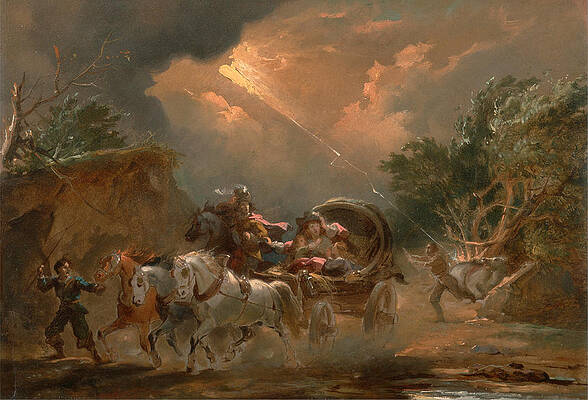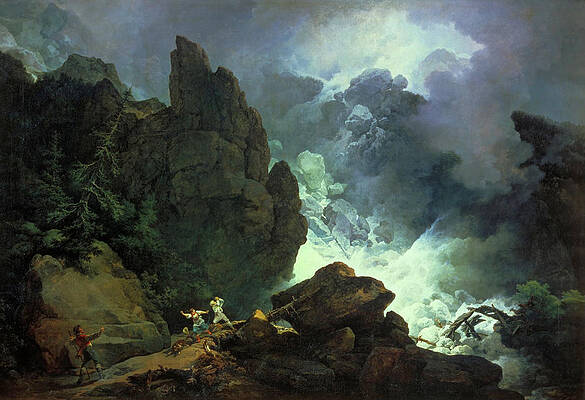Philipp Jakob Loutherbourg the younger
Paintings
The Battle of Alexandria 21 March 1801
The Great Fire of London
Battle at Sea between Soldiers and Oriental Pirates
Coach in a Thunderstorm
The Rainbow

The Battle of Camperdown
Snowdon from Capel Curig
An Avalanche in the Alps
Landscape with Resting Cattle

Evening Seascape with Cumberland

Fine Art Prints | Greeting Cards | Phone Cases | Lifestyle | Face Masks | Men's , Women' Apparel | Home Decor | jigsaw puzzles | Notebooks | Tapestries | ...
The Battle of Alexandria 21 March 1801
Early life
Loutherbourg was born in Strasbourg in 1740, the son of an expatriate Polish miniature painter.[1] Intended for the Lutheran ministry, he was educated at the University of Strasbourg.[2]
Paris
Rejecting a religious calling, Loutherbourg decided to become a painter, and in 1755 placed himself under Charles-André van Loo in Paris and later under Francesco Giuseppe Casanova. His talent developed rapidly, and he became a figure in the fashionable society of the day. In 1767 he was elected to the French Academy, although below the age required by the rules of the institution, and painted landscapes, sea storms, and battles, all of which work had a celebrity above those of the specialists then working in Paris. He made his debut with the exhibition of twelve pictures, including Storm at Sunset, Night, and Morning after Rain.[2]
Defeat of the Spanish Armada, 1588-08-08 by Philip James de Loutherbourg, painted 1796
An avalanche, painted 1803
Travels
Loutherbourg
then travelled through Switzerland, Germany and Italy, distinguishing
himself as much by his mechanical inventions as by his painting. One of
these, showing quite new effects produced in a model theatre, was the
wonder of the day, with its use of lights behind canvas representing
the moon and stars, and the illusory appearance of running water
produced by clear blue sheets of metal and gauze, with loose threads of
silver.[2]
London
Theatre
In 1771 he settled in
London, where David Garrick paid him £500 a year to design scenery and
costumes and oversee the stage machinery at the Drury Lane Theatre.[3]
His stage effects attracted the admiration not just of the general
public, but also of artists, including Joshua Reynolds. He devised
scenic effects in which, for instance, green trees gradually became
russet and the moon rose and lit the edges of passing clouds:[2]
illusions achieved through the use of coloured lantern-slides and the
ingenious lighting of transparencies.[4] He continued to work at the
theatre until 1785.[3]
He achieved an even greater success
with an entertainment called the Eidophusikon, meaning "image of
nature". This was a miniature mechanical theatre measuring six by eight
feet, and described as displaying "Various Imitations of Natural
Phenomena, represented by Moving Pictures". It was presented at
Loutherbourg's home from March 1781 in an auditorium seating about 130
people. He used Argand lamps to light the stage and stained glass to
change colours.
At Christmas, 1781, Loutherbourg mounted a
spectacle at a party in the Egyptian Hall at Fonthill for William
Beckford, promising (according to Beckford) to "present a mysterious
something that the eye has not seen or heart of man conceived".[4]
Following this he attempted rather more fantasical subjects for the
Eidophusikon, presenting a scene from Paradise Lost with Satan arraying
his troops on the banks of the Fiery Lake, and the rising of the Palace
of Pandemonium.[4] The Eidophusikon soon closed, however; as the income
did not cover the costs and the audience demanded new productions
faster than Loutherbourg could create them. He has been called the
inventor of the panorama, but although it first appeared about the same
time as the Eidophusikon, the first panorama was painted and exhibited
by the Scottish painter Robert Barker.
Painting
Coalbrookdale by Night, painted 1801
Despite
these other projects, Loutherbourg still found time for painting. Lord
Howe's action, or the Glorious First of June (exhibited 1795) and other
large naval pictures were commissioned to commemorate British naval
victories, many of them ending up soon afterwards in the Greenwich
Hospital Gallery (in whose successor, the National Maritime Museum,
they still remain). His finest work was the Destruction of the Armada.
He also painted the Great Fire of London and several historical works,
including the Attack of the Combined Armies on Valenciennes (1793).[2]
He was interested in the industrial revolution and his 1801 painting
Coalbrookdale by Night shows iron foundries at work.
Seven of his paintings, including Lodore Waterfall and Skating in Hyde Park, are in the Government Art Collection.[5]
He was made a member of the Royal Academy in 1781.
Publications
Paysage avec animaux, 1767
Two
sets of drawings by de Loutherbourg were published, reproduced in
aquatint, under the title Picturesque English Scenery in 1801 and 1805.
He also contributed illustrations to a bible published by Thomas
Macklin in 1800.[3]
Esoteric interests
In 1789
Loutherbourg temporarily gave up painting, in order to pursue an
interest in alchemy and the supernatural.[3] He met Alessandro di
Cagliostro, who instructed him in the occult.[3] He travelled about
with Cagliostro, leaving him, however, before his condemnation to
death.[2] He and his wife also took up faith-healing. A pamphlet called
A List of a Few Cures performed by Mr and Mrs De Loutherbourg, of
Hammersmith Terrace, without Medicine was published in 1789. Written by
a follower named Mary Pratt, it claimed that the Loutherbourgs had
cured two thousand people between Christmas 1788 and the following
July, "having been made proper recipients to receive divine
manuductions".[6]
Death
Loutherbourg died in Chiswick in 1812.
There are paintings by him in the collections of several British institutions including Leicester, Farnham and Derby Art Gallery.[7]
Further reading
Joppier, Rudiger (1973). Philippe Jacques de Loutherbourg, R.A., 1740-1812. London: Greater London Council.
Dobson, Austin. At Prior Park and Other Papers. London: Humphrey Milford Oxford University Press, 1923. Print.
References
Philip James de Loutherbourg
Baynes, T.S., ed. (1875–1889). "Philip James de Loutherbourg". Encyclopaedia Britannica (9th ed.).
Public Domain One or more of the preceding sentences incorporates text from a publication now in the public domain: Chisholm, Hugh, ed. (1911). "De Loutherbourg, Philip James". Encyclopædia Britannica 7 (11th ed.). Cambridge University Press. p. 973.
Lister, Raymond (1989). British Romantic Painting. Cambridge University Press.
McCalman, Iain (May 2007). "The Virtual Infernal: Philippe de Loutherbourg, William Beckford and the Spectacle of the Sublime publisher=Romanticism on the Net".
coordinators, Andrew Ellis, director ; Sonia Roe, editor ; Julia Abel Smith & Richard Garner, catalogue (2007). Oil paintings in public ownership in the Government Art Collection. London: Public Catalogue Foundation. p. 183. ISBN 1-904931-42-1.
Mackay, Charles (1852). Memoirs of Extraordinary Popular Delusions 1. London. p. 288.
Philip James de Loutherbourg, BBC, accessed August 2011
---
Fine Art Prints | Greeting Cards | Phone Cases | Lifestyle | Face Masks | Men's , Women' Apparel | Home Decor | jigsaw puzzles | Notebooks | Tapestries | ...
---
Artist
A - B - C - D - E - F - G - H - I - J - K - L - M -
N - O - P - Q - R - S - T - U - V - W - X - Y - Z
Retrieved from "http://en.wikipedia.org/"
All text is available under the terms of the GNU Free Documentation License










